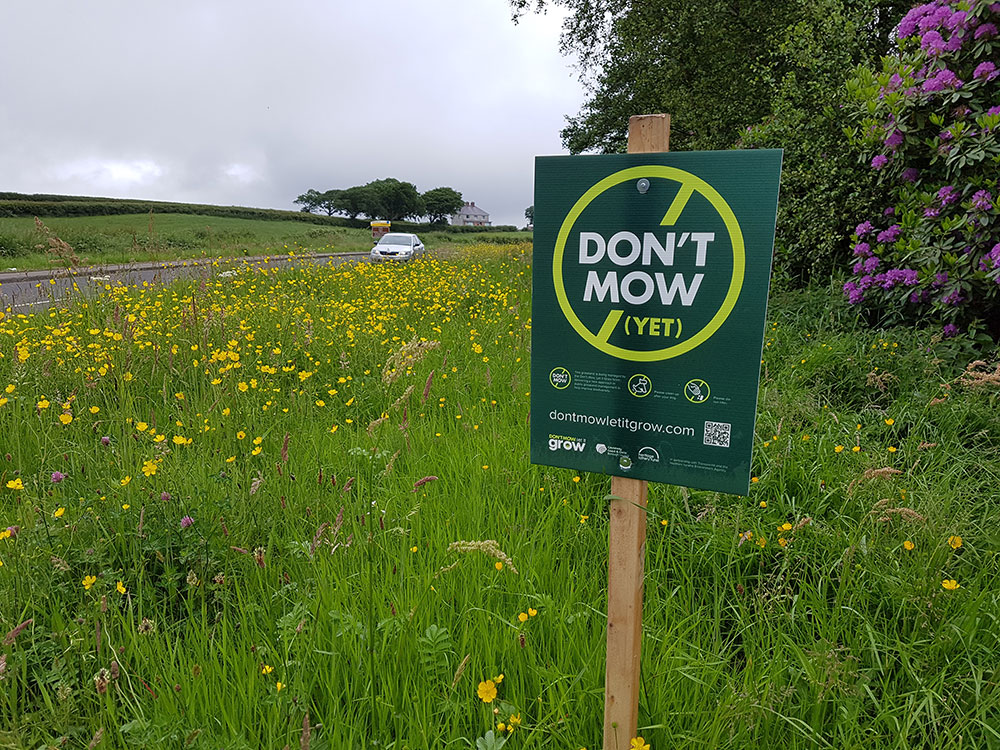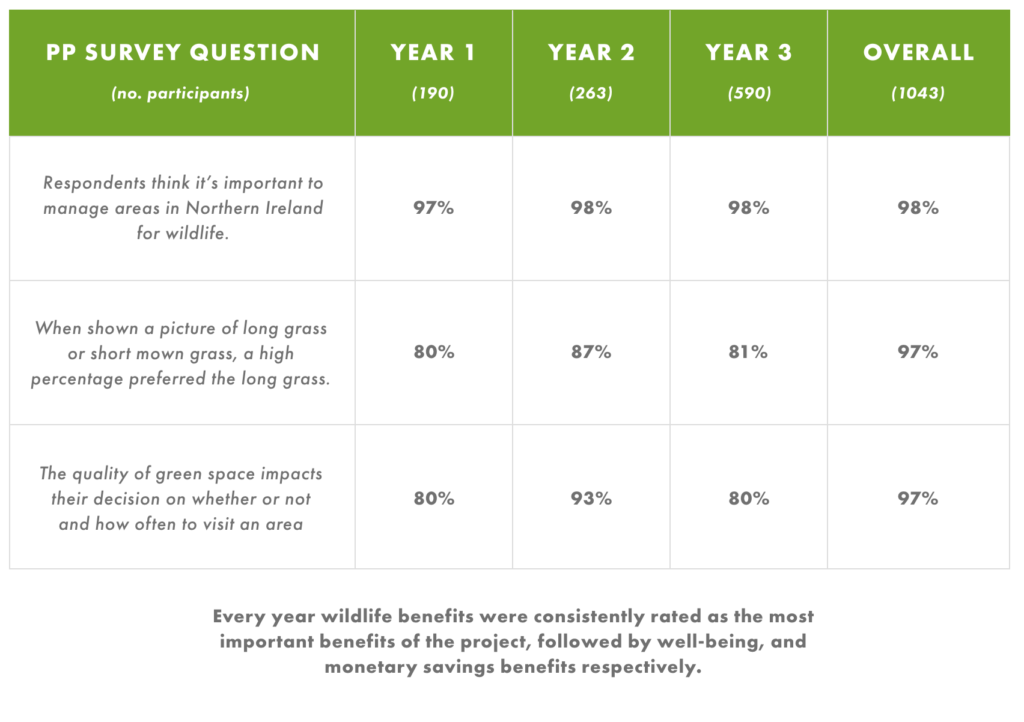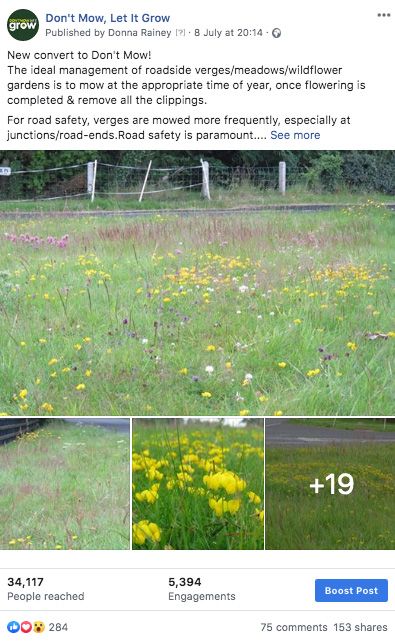To view a short video summarising the project, click here.
Northern Ireland’s traditional flower-rich meadows (hay meadows/semi-natural grasslands) are unique because of their geography, climate and traditional management practices. They are an integral part of our cultural and natural heritage. Our meadows support more flowering plants than any other Northern Ireland habitat type, due to the diversity of flowering plants they in turn support an array of pollinating insects including bees, butterflies and moths. True hay meadows have now largely disappeared because of major changes in agricultural practices but roadside verges and council parks can be managed in such a way as to replicate hay meadow habitat.
Pilot Project

Don’t Mow, Let It Grow was a pilot project which aimed to change the management of some of our road verge and council park grasslands across the Causeway Coast and Glens Borough. It looked at different ways of managing these sites to show how making small changes can provide big benefits to biodiversity, by allowing the grasses and wildflowers to grow on these sites creating meadow grasslands. This, in turn, provides feeding and nesting sites for important pollinators such as bees and butterflies. In most instances, these sites were cut and where possible lifted once a year, instead of several times over the summer months, giving flowers the chance to bloom and set seed.
The project was inspired by a small scale trial in the Garvagh area changing the management of a small number of road verges, which proved very successful. The partners involved agreed to try and develop a borough-wide pilot project to see if this would work as an alternative management style for our public grasslands.
Partnership Working

The project partners; Causeway Coast and Glens Borough Council (CCGBC), Department for Infrastructure Roads (DfI Roads), Northern Ireland Environment Agency (NIEA) and Donna Rainey (volunteer), developed a successful two-phase funding application to National Lottery Heritage Fund (as was Heritage Lottery Fund) with match funding for the development phase from NIEA and for the delivery phase from Landfill Communities Fund. A total of £150,000 was secured with £10k for development and £140k for delivery.
During the 12-month development phase, environmental consultants were appointed, working alongside the project partners/steering group in order to develop a site selection strategy and select an initial suite of road verges and council parks, along with developing a training and activity plan.
The steering group also developed the second round application, including project targets, action plan and timelines, public perception survey, PR and engagement plans, consultant’s briefs and tender documents.
Number of Sites Growing

The delivery phase was initially 3 years and proved to be very popular and successful, now encompassing some 19 DfI Roads verges and 17 Council sites spread across the Borough, equating to over 11Ha of Council land now being managed as meadows for the benefit of our community and visitors, as well as our native wildflowers and pollinators.
Small Change in Management, Big Benefits
Management guidelines have now been developed for all of the sites, highlighting the optimal management and the important species on each site. This management has been carried out through a combination of estates staff, contractors, volunteers, and local farmers who cut and lift the grass for fodder and on one site winter cattle grazing. There are currently three Council meadows cut & lifted by local farmers for fodder at zero cost. Due to the cost-saving derived from using a variety of management methods the project was able to purchase a Peruzzo Koala cut & lift mower, which will enable more in-house management of the smaller DMLIG site and other Council grasslands. With the Council investing in a larger Amazone cut and lift mower to manage some of the larger sites. Grass that was cut and lifted by the Council and volunteers was taken to green waste sites for compositing.
Transformation

The transformation in these sites has been remarkable, which has been shown through the results of the biodiversity surveys carried out annually by volunteers.
For example:
- Joey Dunlop Centre now has 3 species of orchid; marsh, northern and common spotted
- Ramore Head now has a vast array of heath spotted orchids, spring squill and field gentian
- Portaneevy has beautiful knapweed, wild thyme and common blue butterflies
- Greysteel Glen is full of cuckoo flower, marsh bedstraw and water forget-me-not
- Rasharkin has been transformed from rank chest-deep thistles and nettles to fine grasses, clovers and orchids
Click here to see before and after images.
Small Changes, Big Benefits

The DMLIG sites also have a number of notable rare plant and insect species turning up, including green figwort and bee orchid, along with heather colletes and bilberry bumblebees.
No Reseeding
DMLIG did not reseed any sites, just changed the management, which allowed all these species waiting in the seedbank a chance to grow and flourish. This is much preferred as the species are adapted for the sites and there is no cost involved.
The project mantra of ‘small change of management, big benefits’ has certainly been proven. Not only has there been big biodiversity benefits but there are also significant cost savings; for the 11Ha of Council land within the DMLIG project, the estimated saving is £63,104 annually as calculated in the projects Economic Appraisal carried out by Eftec.
High Engagement

The engagement levels for the dedicated website (www.dontmowletitgrow.com) and Facebook page (don’t mow let it grow) continue to grow, with 3,307 visitors to the website and over 2,900 followers on the Facebook page. Both have proved invaluable in engaging with the wider community and other organisations who manage grasslands.
There has been excellent volunteer engagement, with a core of over 40 volunteers involved in the project from carrying out habitat surveys, taking photos of the sites, assisting with the events, promoting the project, getting involved in the practical management of the sites and including managing the project Facebook page. The volunteers and project partners ‘in-kind’ contribution amounts to a staggering £230,000 plus! Without the dedicated support of these exceptional individuals, this project would not have been such an outstanding success.
DMLIG interactive stands attended 27 events engaging with over 5,500 people over the project life span including; Riverfest, Airwaves, Salmon & Whiskey Festival, Ballymoney Spring Fair, Lark in the Park, along with hundreds of local events and talks to community groups. There was an array of promotional materials including leaflets, frisbees, windows stickers and cloth bags for life handed out.
Project Celebration

In 2018 the project hosted an event in Flowerfield Art Centre to celebrate the project’s achievements with its partners and volunteers along with organisations and individuals who had connected with the project. It was an excellent event, with the project partners and funders sharing their experiences and culminating in an inspirational keynote speech from the award-winning wildlife cameraman and TV presenter Simon King.
Education
Buzzy Flo and friends were also created to help engage primary school children. Six, two-minute animations were developed along with presenter script and teachers notes, in order to engage children about pollination, meadows, invasive species and what they can do help. This education programme was trialled in 4 schools across the Borough engaging approximately 120 pupils. In addition, there were volunteers trained who now can deliver the programme in schools upon request. A teacher’s pack was developed to enable them to deliver the programme themselves.
Training
Training was a major element of this project and each year toolbox talks were given to all the relevant staff in Council estate depots along with two DfI Roads sections. There was also a variety of training annually for the project volunteers including biodiversity survey training, wildflower identification, Invasive Alien Species identification and management, habitat management, use of Austrian scythe, which were all very popular and well attended. Totalling more than 30 training sessions.
Excellent Public Support
Key information was gathered through the Public Perception Survey, which was carried out annually to provide evidence of the support and benefits of DMLIG. More than 1000 surveys were completed over the 3 years and some of the results are summarised below:

Far Reaching
Throughout the project, many other organisations and individuals have watched the progress of the project, seeking advice and help to develop their own DMLIG style projects including; Ards & North Down Council, Mid Ulster Council, ABC Council, Causeway Hospital, the new DAERA offices at Ballykelly, Roe Valley Country Park, Thiepvial Barracks to name but a few. The project has made contact, influenced people and organisations from Craigavon to America, the Netherlands to Mid Ulster, England to Wales and beyond.
Huge Success

The project has been a huge success and reached hundreds of thousands of people with an overwhelmingly positive response, in addition to establishing meadows within the Causeway Coast and Glens Borough and beyond.
The project used all the data collected from the various project activities to carry out a cost-benefit analysis, not just looking at the monetary benefits which are positive cost savings but also looking at wider economic benefits, health and wellbeing, and ecosystem services benefit too. (See the full report; ‘Don’t Mow, Let It Grow Economic Appraisal of Grassland Management’)
A Toolkit For Your Area
The final phase of the project was the creation of the toolkit, which contains all the materials generated by the project from survey forms, training programmes, management options, site selection criteria, cost-benefit analysis, brand guidelines, signs, Buzzy Flo education pack, etc. which are all available for download on the website for everyone to use to help spread the message and develop their own DMLIG style projects.
The positive public engagement and increased biodiversity of the project sites have created a change in management of our public grasslands which will be continued by not only DfI Roads and Causeway Coast and Glens Borough Council, but other Councils and organisations such as Mid Ulster and DAERA creating a lasting legacy, which shows that ‘Small change in management, big benefit’!
To view a short video summarising the project, click here.
